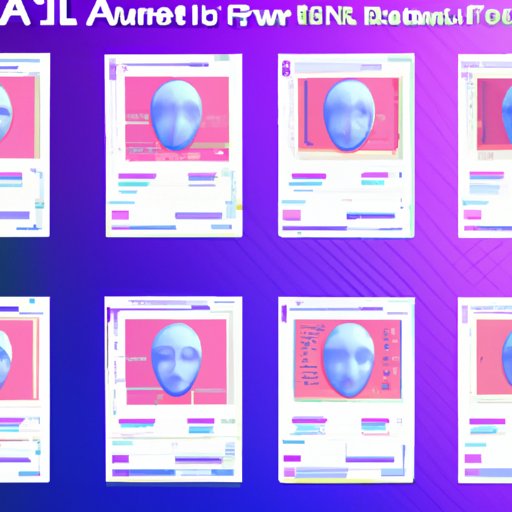Introduction
AI files are vector image files created using Adobe Illustrator software. These files are known for their high quality, scalability, and versatility, making them ideal for graphic design projects. However, editing AI files can be difficult if you don’t have the right knowledge or experience. This article will provide an overview of editing AI files, as well as step-by-step instructions and tips for beginners.
Step-by-Step Guide to Editing AI Files
Editing AI files requires a certain level of skill and understanding. To help you get started, here is a step-by-step guide to editing AI files:
Setting up the Software
The first step in editing AI files is to make sure you have the proper software installed. Adobe Illustrator is the most popular program for creating and editing AI files, so you’ll need to make sure you have the latest version of the software before you begin. Once you’ve got the software installed and updated, you can move on to the next step.
Working with Layers
Layers are essential when it comes to editing AI files. They allow you to separate different elements of your design, making it easier to work with each element individually. When setting up layers in your AI file, make sure to label each layer clearly so you know what elements are contained in each layer. This will help you keep track of your work and make any necessary changes quickly and efficiently.
Using Selections & Tools
Once you’ve set up your layers, you can start making changes to your AI file. The selection tool allows you to select specific elements of your design, while the transform tool lets you manipulate those elements. You can also use the pen tool to create new shapes and paths, as well as the brush tool to add color and texture to your design.
Exporting Your Work
When you’re finished making changes to your AI file, you’ll need to export the file in order to share it with others. To do this, simply go to the File menu and select “Export”. From there, you can choose the format you’d like to save your file in (such as JPEG, PNG, or PDF). Once you’ve exported the file, it’s ready to be shared with others.
A Beginner’s Guide to Editing AI Files
If you’re a beginner to editing AI files, there are a few things you should know before you get started. Here is a beginner’s guide to editing AI files:
Understanding the Basics
The first step to editing AI files is to understand the basics. Start by familiarizing yourself with the various tools available in Adobe Illustrator and learning how they can be used to manipulate vector images. You should also become familiar with the concept of layers and how to use them to organize your design elements.
Learning the Interface
Once you’ve got the basics down, it’s time to get comfortable with the interface. Take some time to explore the menus and tools available in Adobe Illustrator. This will help you become more efficient when making changes to your AI files.
Exploring the Features
Adobe Illustrator has many features that can help you create amazing designs. Spend some time exploring these features and learning how to use them to get the most out of your AI files. From applying effects and filters to utilizing clipping masks, there are plenty of ways to make your designs stand out.
Tips and Tricks for AI File Editing
Once you’ve mastered the basics of editing AI files, it’s time to move on to more advanced techniques. Here are some tips and tricks for AI file editing:
Working with Shortcuts
Using shortcuts is a great way to speed up your workflow when editing AI files. Learning the keyboard shortcuts will help you quickly select and manipulate elements in your design without having to navigate through menus. Some of the most commonly used shortcuts include Ctrl+C (copy), Ctrl+V (paste), and Ctrl+Z (undo).
Applying Effects & Filters
Effects and filters can add visual interest to your designs. Experiment with different effects and filters to find the ones that best suit your project. You can also combine multiple effects and filters to create unique looks for your AI files.
Utilizing Clipping Masks
Clipping masks are a powerful tool for creating complex designs. By using a clipping mask, you can easily apply effects and filters to only certain parts of your design. This can be a great way to add depth and texture to your AI files.

Troubleshooting Common AI File Editing Issues
Sometimes, you may run into issues when editing AI files. Here are some tips for troubleshooting common AI file editing issues:
Resolving Compatibility Issues
If you’re having trouble opening or exporting your AI files, it could be due to compatibility issues. Make sure you have the most recent version of Adobe Illustrator installed and try opening the file again. If that doesn’t work, try re-saving the file in a different format.
Fixing Color Issues
If you’re seeing unexpected colors or inconsistencies when editing your AI files, it could be due to color management issues. To fix this, make sure you’re using the correct color profile and that your monitor is calibrated correctly. You can also try converting the file to CMYK mode to ensure consistent colors.
Solving File Corruption Problems
If your AI file is corrupted or won’t open, it could be due to a number of issues. Try using a reliable file recovery tool to recover the corrupted file. If that doesn’t work, you may need to recreate the file from scratch.

Exploring Advanced AI File Editing Techniques
Once you’ve mastered the basics of editing AI files, you can start exploring more advanced techniques. Here are some of the most popular advanced AI file editing techniques:
Animating Vector Graphics
Using Adobe After Effects, you can animate your vector graphics to create stunning motion graphics. This is a great way to add life to your AI files and create eye-catching visuals.
Creating 3D Objects
Using Adobe Dimension, you can create 3D objects from your AI files. This is a great way to add depth and realism to your designs.
Working with Scripts
Scripts allow you to automate tedious tasks when editing AI files. There are many scripts available online that can help simplify and streamline your workflow.
Conclusion
Editing AI files can be complex, but with the right knowledge and experience, anyone can become proficient at it. This article has provided an overview of editing AI files, as well as step-by-step instructions and tips for beginners. We’ve also explored some of the more advanced techniques, such as animating vector graphics, creating 3D objects, and working with scripts. With practice, you’ll be able to create stunning designs with AI files.
(Note: Is this article not meeting your expectations? Do you have knowledge or insights to share? Unlock new opportunities and expand your reach by joining our authors team. Click Registration to join us and share your expertise with our readers.)
